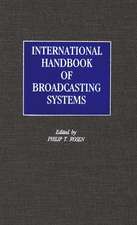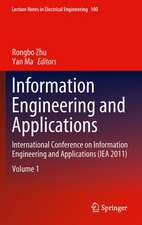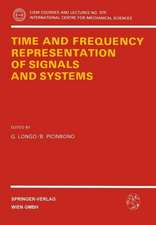Public Data Networks: From Separate PDNs to the ISDN
Autor Josef Puzman, Boris Kubinen Limba Engleză Paperback – 16 dec 1991
Preț: 387.75 lei
Nou
Puncte Express: 582
Preț estimativ în valută:
74.19€ • 77.47$ • 61.27£
74.19€ • 77.47$ • 61.27£
Carte tipărită la comandă
Livrare economică 15-29 aprilie
Preluare comenzi: 021 569.72.76
Specificații
ISBN-13: 9783540195801
ISBN-10: 3540195807
Pagini: 252
Ilustrații: X, 241 p. 2 illus.
Dimensiuni: 170 x 244 x 13 mm
Greutate: 0.41 kg
Ediția:Softcover reprint of the original 1st ed. 1992
Editura: SPRINGER LONDON
Colecția Springer
Locul publicării:London, United Kingdom
ISBN-10: 3540195807
Pagini: 252
Ilustrații: X, 241 p. 2 illus.
Dimensiuni: 170 x 244 x 13 mm
Greutate: 0.41 kg
Ediția:Softcover reprint of the original 1st ed. 1992
Editura: SPRINGER LONDON
Colecția Springer
Locul publicării:London, United Kingdom
Public țintă
ResearchCuprins
1 Introduction.- 2 Public Data Network Principles.- 2.1 Basic Terms.- 2.2 Data Transmission in PDNs.- 2.3 Data Transmission in the ISDN.- 3 Switching in Networks.- 3.1 Network Capacity Sharing.- 3.2 Circuit Switching.- 3.3 Packet Switching.- 3.4 Network Management.- 4 Network Architectures.- 4.1 Functions and Services.- 4.2 Methods of Some Functions.- 4.3 Principles of the Layered Architecture.- 4.4 Layered Models of Networks.- 4.5 Physical Layer.- 4.6 Link Layer.- 4.7 Network Layer.- 4.8 Higher Layers.- 5 PDN Supported Services and Facilities.- 5.1 Basic Means and Basic Classification.- 5.2 Data Transmission Services.- 5.3 User Facilities.- 5.4 Support of Complete Telecommunication Services.- 5.5 Support of PDN-Type Services and Facilities by the ISDN.- 6 DTE Access to Public Services and Networks.- 6.1 Significance of Access Specifications.- 6.2 Access through PADs.- 6.3 Access Via TAs.- 6.4 Direct Access.- 6.5 Switched Access.- 6.6 Numbering Plans and Directory Services.- 7 Network Performance.- 7.1 Two Approaches to Network Performance Assessment.- 7.2 General Parameters.- 7.3 Tariff Policies.- 7.4 Network Security.- 8 Network Standards.- 8.1 The Importance of Standardization for PDNs.- 8.2 Worldwide Standardization Organizations.- 8.3 Regional Standardization Organizations.- 9 Trends in Networks and Services.- Appendix 1. Basic Terms.- Appendix 2. Network Identification Codes.- Appendix 3. CCITT Recommendations.- Appendix 4. ISO Standards.- Appendix 5. Abbreviations.- References.




















